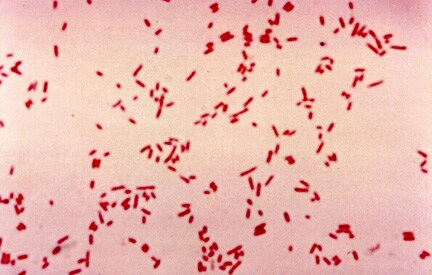

Cells are stained with crystal violet dye.Due to differences in the thickness of a peptidoglycan layer in the cell membrane between Gram positive and Gram negative bacteria, Gram positive bacteria (with a thicker peptidoglycan layer) retain crystal violet stain during the decolorization process, while Gram negative bacteria lose the crystal violet stain and are instead stained by the safranin in the final staining process. Gram staining involves three processes: staining with a water-soluble dye called crystal violet, decolorization, and counterstaining, usually with safanin. Alternatively, Gram negative bacteria stain red, which is attributed to a thinner peptidoglycan wall, which does not retain the crystal violet during the decoloring process.

Gram positive bacteria stain violet due to the presence of a thick layer of peptidoglycan in their cell walls, which retains the crystal violet these cells are stained with. The Gram stain procedure distinguishes between Gram positive and Gram negative groups by coloring these cells red or violet.

Gram staining is a common technique used to differentiate two large groups of bacteria based on their different cell wall constituents. Twenty-five patients receiving care in hospital, 22 of whom were confirmed as having hemolytic uremic syndrome. Six patients were receiving peritoneal dialysis.Anthrax gram stain. 12, AHS said the outbreak had grown to include 264 lab-confirmed cases, mostly among children. 12, the exact cause of the outbreak was still under investigation but Alberta Health Services said it was believed to have originated in a food source from a central kitchen used by multiple daycares. None were hospitalized.Ģ023: An outbreak of E. Eight were hospitalized.Ģ022: Contaminated kimchi sickened 14 people in Alberta and Saskatchewan.

coli bacteria linked to meat from the plant.Ģ014: Contaminated pork sickened 119 Albertans.Ģ018: Eighteen people in Quebec and Ontario were infected and six were hospitalized after eating contaminated lettuce.Ģ019: Packaged salad kits were identified as the most likely source of contamination that infected 28 people across seven provinces. (Jeff McIntosh/The Canadian Press)Ģ012: XL Foods recalled more than 1.8 million kilograms of beef in Canada and the United States from a processing plant then operated by XL Foods Inc., in Brooks, Alta., after health officials confirmed that 18 Canadians tested positive for E. coli outbreak prompted the largest meat recall in Canadian history. Two people wearing fluorescent safety vests stand atop a pile of packaged beef products from the XL Foods cattle processing plant as more are dumped at a landfill site near Brooks, Alta., on Oct. Two people died.ġ999: Dry salami was linked to an outbreak in British Columbia that infected 143 people.Ģ000: Canada's largest outbreak occurred in Walkerton, Ont., when manure-tainted drinking water caused more than 2,300 cases. Contaminated beef and caribou were considered the likely sources of outbreaks that caused 22 cases of hemolytic uremic syndrome. Nineteen residents died.ġ991: In what was then the Northwest Territories, 521 Inuit in six communities were sickened over several months. Undercooked hamburger was the suspected source.ġ985: Seventy-three residents and staff in a nursing home in London, Ont., fell sick after eating uncooked meat in sandwiches. Doctors traced the outbreak to unpasteurized apple juice.ġ982: An outbreak in an Ottawa nursing home affected 31 residents. coli, 14 Toronto-area children fell sick with hemolytic uremic syndrome and one of them eventually died. coli O157 outbreaks.ġ980: In one of the first recognized outbreaks of the E. Here's a chronological list of some of Canada's other major E. coli and why are Calgary children getting so sick?


 0 kommentar(er)
0 kommentar(er)
